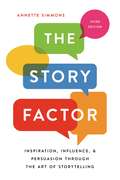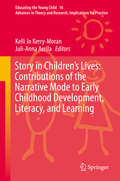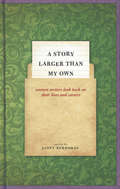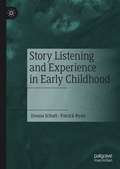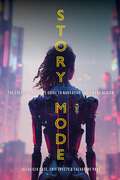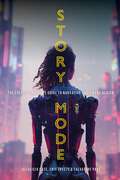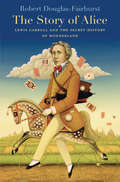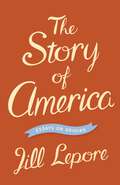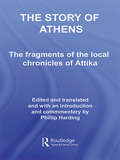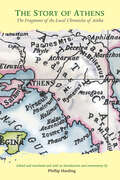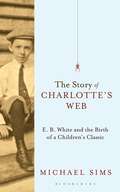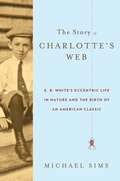- Table View
- List View
Story Chest, Ready-Set-Go Books: Little Pig (PDF)
by June MelserGo home, said the butcher, or I'll make you into sausages.Story Chest is a scheme of high interest readers for KS1/2. This well-known series has self-contained, funny and predictable stories. Good for using with beginner readers and reluctant/SEN readers because of the style and predictable text.
Story Chest, Stage 1, Read-Together Books: Dan the Flying Man
by Joy Cowley"'I am Dan, the flying man. Catch me, catch me, if you can.'" "Story Chest" is a scheme of high interest readers for KS1/2. This well-known series has self-contained, funny and predictable stories. Good for using with beginner readers and reluctant/SEN readers because of the style and predictable text.
The Story Factor: Inspiration, Influence, and Persuasion through the Art of Storytelling
by Annette SimmonsFully revised, updated, and expanded, this modern classic will teach you to use the art of storytelling to persuade, motivate, and inspire in life and business Anyone seeking to influence others must first know their own story, and how to tell it properly. Whether you're proposing a risky new venture, trying to close a deal, or leading a charge against injustice, you have a story to tell. Tell it well and you will create a shared experience with your listeners that can have profound results.In this modern classic, Annette Simmons reminds us that the oldest tool of influence is also the most powerful. Fully revised and updated to account for new technology and social media, along with two new chapters on the role of stories in the development of civilization and how to adjust your story to your specific goal, Simmons showcases over a hundred examples of effective storytelling drawn from the front lines of business and government, as well as myths, fables, and parables from around the world. Whether writing a screenplay, or announcing a corporate reorganization, Simmons illustrates how story can be used in ways that cold facts, bullet points, and directives can't. These stories, combined with practical storytelling techniques, show anyone how to become a more effective communicator and achieve their goals.
Story in Children's Lives: Contributions of the Narrative Mode to Early Childhood Development, Literacy, and Learning (Educating the Young Child #16)
by Kelli Jo Kerry-Moran Juli-Anna AerilaThis book is based on the power of stories to support children in all areas of their lives. It examines the role narratives can play in encouraging growth in contexts and domains such as personal and family identity, creative movement, memory and self-concept, social relationships, or developing a sense of humor. Each chapter describes innovative and research-based applications of narratives such as movement stories, visual narratives to develop historical thinking, multimodal storytelling, bibliotherapy, mathematics stories, family stories, and social narratives. The chapters elaborate on the strength of narratives in supporting the whole child in diverse contexts from young children on the autism spectrum improving their social skills at school, to four- and five-year-olds developing historical thinking, to children who are refugees or asylum-seekers dealing with uncertainty and loss. Written by accomplished teachers, researchers, specialists, teaching artists and teacher educators from several countries and backgrounds, the book fills a gap in the literature on narratives. “…this work delves into the topic of narratives in young children’s lives with a breadth of topics and depth of study not found elsewhere.” “Collectively, the insights of the contributors build a convincing case for emphasizing story across the various disciplines and developmental domains of the early childhood years.” “The writing style is scholarly, yet accessible. Authors used a wide array of visual material to make their points clearer and show the reader what meaningful uses of story “look like”.” Mary Renck Jalongo, Journal and Book Series Editor Springer Indiana, PA, USA
A Story Larger than My Own: Women Writers Look Back on Their Lives and Careers
by Janet BurrowayIn 1955, Maxine Kumin submitted a poem to the Saturday Evening Post. “Lines on a Half-Painted House” made it into the magazine—but not before Kumin was asked to produce, via her husband’s employer, verification that the poem was her original work. Kumin, who went on to win the Pulitzer Prize for poetry, was part of a groundbreaking generation of women writers who came of age during the midcentury feminist movement. By challenging the status quo and ultimately finding success for themselves, they paved the way for future generations of writers. In A Story Larger than My Own, Janet Burroway brings together Kumin, Julia Alvarez, Jane Smiley, Erica Jong, and fifteen other accomplished women of this generation to reflect on their writing lives. The essays and poems featured in this collection illustrate that even writers who achieve critical and commercial success experience a familiar pattern of highs and lows over the course of their careers. Along with success comes the pressure to sustain it, as well as a constant search for subject matter, all too frequent crises of confidence, the challenges of a changing publishing scene, and the difficulty of combining writing with the ordinary stuff of life—family, marriage, jobs. The contributors, all now over the age of sixty, also confront the effects of aging, with its paradoxical duality of new limitations and newfound freedom. Taken together, these stories offer advice from experience to writers at all stages of their careers and serve as a collective memoir of a truly remarkable generation of women.
A Story Larger than My Own: Women Writers Look Back on Their Lives and Careers
by Janet BurrowayIn 1955, Maxine Kumin submitted a poem to the Saturday Evening Post. “Lines on a Half-Painted House” made it into the magazine—but not before Kumin was asked to produce, via her husband’s employer, verification that the poem was her original work. Kumin, who went on to win the Pulitzer Prize for poetry, was part of a groundbreaking generation of women writers who came of age during the midcentury feminist movement. By challenging the status quo and ultimately finding success for themselves, they paved the way for future generations of writers. In A Story Larger than My Own, Janet Burroway brings together Kumin, Julia Alvarez, Jane Smiley, Erica Jong, and fifteen other accomplished women of this generation to reflect on their writing lives. The essays and poems featured in this collection illustrate that even writers who achieve critical and commercial success experience a familiar pattern of highs and lows over the course of their careers. Along with success comes the pressure to sustain it, as well as a constant search for subject matter, all too frequent crises of confidence, the challenges of a changing publishing scene, and the difficulty of combining writing with the ordinary stuff of life—family, marriage, jobs. The contributors, all now over the age of sixty, also confront the effects of aging, with its paradoxical duality of new limitations and newfound freedom. Taken together, these stories offer advice from experience to writers at all stages of their careers and serve as a collective memoir of a truly remarkable generation of women.
A Story Larger than My Own: Women Writers Look Back on Their Lives and Careers
by Janet BurrowayIn 1955, Maxine Kumin submitted a poem to the Saturday Evening Post. “Lines on a Half-Painted House” made it into the magazine—but not before Kumin was asked to produce, via her husband’s employer, verification that the poem was her original work. Kumin, who went on to win the Pulitzer Prize for poetry, was part of a groundbreaking generation of women writers who came of age during the midcentury feminist movement. By challenging the status quo and ultimately finding success for themselves, they paved the way for future generations of writers. In A Story Larger than My Own, Janet Burroway brings together Kumin, Julia Alvarez, Jane Smiley, Erica Jong, and fifteen other accomplished women of this generation to reflect on their writing lives. The essays and poems featured in this collection illustrate that even writers who achieve critical and commercial success experience a familiar pattern of highs and lows over the course of their careers. Along with success comes the pressure to sustain it, as well as a constant search for subject matter, all too frequent crises of confidence, the challenges of a changing publishing scene, and the difficulty of combining writing with the ordinary stuff of life—family, marriage, jobs. The contributors, all now over the age of sixty, also confront the effects of aging, with its paradoxical duality of new limitations and newfound freedom. Taken together, these stories offer advice from experience to writers at all stages of their careers and serve as a collective memoir of a truly remarkable generation of women.
A Story Larger than My Own: Women Writers Look Back on Their Lives and Careers
by Janet BurrowayIn 1955, Maxine Kumin submitted a poem to the Saturday Evening Post. “Lines on a Half-Painted House” made it into the magazine—but not before Kumin was asked to produce, via her husband’s employer, verification that the poem was her original work. Kumin, who went on to win the Pulitzer Prize for poetry, was part of a groundbreaking generation of women writers who came of age during the midcentury feminist movement. By challenging the status quo and ultimately finding success for themselves, they paved the way for future generations of writers. In A Story Larger than My Own, Janet Burroway brings together Kumin, Julia Alvarez, Jane Smiley, Erica Jong, and fifteen other accomplished women of this generation to reflect on their writing lives. The essays and poems featured in this collection illustrate that even writers who achieve critical and commercial success experience a familiar pattern of highs and lows over the course of their careers. Along with success comes the pressure to sustain it, as well as a constant search for subject matter, all too frequent crises of confidence, the challenges of a changing publishing scene, and the difficulty of combining writing with the ordinary stuff of life—family, marriage, jobs. The contributors, all now over the age of sixty, also confront the effects of aging, with its paradoxical duality of new limitations and newfound freedom. Taken together, these stories offer advice from experience to writers at all stages of their careers and serve as a collective memoir of a truly remarkable generation of women.
A Story Larger than My Own: Women Writers Look Back on Their Lives and Careers
by Janet BurrowayIn 1955, Maxine Kumin submitted a poem to the Saturday Evening Post. “Lines on a Half-Painted House” made it into the magazine—but not before Kumin was asked to produce, via her husband’s employer, verification that the poem was her original work. Kumin, who went on to win the Pulitzer Prize for poetry, was part of a groundbreaking generation of women writers who came of age during the midcentury feminist movement. By challenging the status quo and ultimately finding success for themselves, they paved the way for future generations of writers. In A Story Larger than My Own, Janet Burroway brings together Kumin, Julia Alvarez, Jane Smiley, Erica Jong, and fifteen other accomplished women of this generation to reflect on their writing lives. The essays and poems featured in this collection illustrate that even writers who achieve critical and commercial success experience a familiar pattern of highs and lows over the course of their careers. Along with success comes the pressure to sustain it, as well as a constant search for subject matter, all too frequent crises of confidence, the challenges of a changing publishing scene, and the difficulty of combining writing with the ordinary stuff of life—family, marriage, jobs. The contributors, all now over the age of sixty, also confront the effects of aging, with its paradoxical duality of new limitations and newfound freedom. Taken together, these stories offer advice from experience to writers at all stages of their careers and serve as a collective memoir of a truly remarkable generation of women.
A Story Larger than My Own: Women Writers Look Back on Their Lives and Careers
by Janet BurrowayIn 1955, Maxine Kumin submitted a poem to the Saturday Evening Post. “Lines on a Half-Painted House” made it into the magazine—but not before Kumin was asked to produce, via her husband’s employer, verification that the poem was her original work. Kumin, who went on to win the Pulitzer Prize for poetry, was part of a groundbreaking generation of women writers who came of age during the midcentury feminist movement. By challenging the status quo and ultimately finding success for themselves, they paved the way for future generations of writers. In A Story Larger than My Own, Janet Burroway brings together Kumin, Julia Alvarez, Jane Smiley, Erica Jong, and fifteen other accomplished women of this generation to reflect on their writing lives. The essays and poems featured in this collection illustrate that even writers who achieve critical and commercial success experience a familiar pattern of highs and lows over the course of their careers. Along with success comes the pressure to sustain it, as well as a constant search for subject matter, all too frequent crises of confidence, the challenges of a changing publishing scene, and the difficulty of combining writing with the ordinary stuff of life—family, marriage, jobs. The contributors, all now over the age of sixty, also confront the effects of aging, with its paradoxical duality of new limitations and newfound freedom. Taken together, these stories offer advice from experience to writers at all stages of their careers and serve as a collective memoir of a truly remarkable generation of women.
Story Listening and Experience in Early Childhood
by Patrick Ryan Donna SchattThis book shows connections between oral story listening and unique, enduring educational effects in and outside of the classroom. Using scientific studies and interviews, as well as personal observations from more than thirty years in schools and libraries, the authors examine learning outcomes from frequent story listening. Throughout the book, Schatt and Ryan illustrate that experiencing stories told entirely from memory transforms individuals and builds community, affecting areas such as reading comprehension, visualization, focus, flow states, empathy, attachment, and theory of mind.
Story Logic and the Craft of Fiction
by Catherine BradyThis book illuminates how technique serves 'story logic,' the particular way fiction makes meaning. Writers raid the cupboard of theory looking for what works, and generic rules don't account for the rich variety of strategies they employ. For writers who are past the beginner stage, Brady offers a closer look at craft fundamentals, including plot, characterization, patterns of imagery, and style. The lively, lucid discussion draws on vivid examples from classic and contemporary fiction, ranging from George Eliot and William Faulkner to Haruki Murakami and Toni Morrison. Because it supplies the analytical tools needed to read as a writer, this text will enrich the reader's approach to any work of fiction, energizing discussion in a workshop or craft course.
Story Logic and the Craft of Fiction
by Catherine BradyThis book illuminates how technique serves 'story logic,' the particular way fiction makes meaning. Writers raid the cupboard of theory looking for what works, and generic rules don't account for the rich variety of strategies they employ. For writers who are past the beginner stage, Brady offers a closer look at craft fundamentals, including plot, characterization, patterns of imagery, and style. The lively, lucid discussion draws on vivid examples from classic and contemporary fiction, ranging from George Eliot and William Faulkner to Haruki Murakami and Toni Morrison. Because it supplies the analytical tools needed to read as a writer, this text will enrich the reader's approach to any work of fiction, energizing discussion in a workshop or craft course.
Story Mode: The Creative Writer's Guide to Narrative Video Game Design
by Professor Julialicia Case Professor Eric Freeze Professor Salvatore PaneAgainst the backdrop of a hyper-competitive AAA industry and the perception that it is a world reserved for top programmers and hard-core 'gamers', Story Mode offers an accessible entry-point for all into writing and designing complex and emotionally affecting narrative video games. The first textbook to combine game design with creative writing techniques, this much-needed resource makes the skills necessary to consume and create digital and multi-modal stories attainable and fun. Appealing to the growing calls for greater inclusivity and access to this important contemporary apparatus of expression, this book offers low-cost, accessible tools and instruction that bridge the knowledge gap for creative writers, showing them how they can merge their skill-set with the fundamentals of game creation and empowering them to produce their own games which push stories beyond the page and the written word. Broken down into 4 sections to best orientate writers from any technological background to the strategies of game production, this book offers: - Contextual and introductory chapters exploring the history and variety of various game genres. - Discussions of how traditional creative writing approaches to character, plot, world-building and dialogue can be utilised in game writing. - An in-depth overview of game studies concepts such as game construction, interactivity, audience engagement, empathy, real-world change and representation that orientate writers to approach games from the perspective of a designer. - A whole section on the practical elements of work-shopping, tools, collaborative writing as well as extended exercises guiding readers through long-term, collaborative, game-centred projects using suites and tools like Twine, Audacity, Bitsy, and GameMaker. Featuring detailed craft lessons, hands-on exercises and case studies, this is the ultimate guide for creative writers wanting to diversify into writing for interactive, digital and contemporary modes of storytelling. Designed not to lay out a roadmap to a successful career in the games industry but to empower writers to experiment in a medium previously regarded as exclusive, this book demystifies the process behind creating video games, orienting readers to a wide range of new possible forms and inspiring them to challenge mainstream notions of what video games can be and become.
Story Mode: The Creative Writer's Guide to Narrative Video Game Design
by Professor Julialicia Case Professor Eric Freeze Professor Salvatore PaneAgainst the backdrop of a hyper-competitive AAA industry and the perception that it is a world reserved for top programmers and hard-core 'gamers', Story Mode offers an accessible entry-point for all into writing and designing complex and emotionally affecting narrative video games. The first textbook to combine game design with creative writing techniques, this much-needed resource makes the skills necessary to consume and create digital and multi-modal stories attainable and fun. Appealing to the growing calls for greater inclusivity and access to this important contemporary apparatus of expression, this book offers low-cost, accessible tools and instruction that bridge the knowledge gap for creative writers, showing them how they can merge their skill-set with the fundamentals of game creation and empowering them to produce their own games which push stories beyond the page and the written word. Broken down into 4 sections to best orientate writers from any technological background to the strategies of game production, this book offers: - Contextual and introductory chapters exploring the history and variety of various game genres. - Discussions of how traditional creative writing approaches to character, plot, world-building and dialogue can be utilised in game writing. - An in-depth overview of game studies concepts such as game construction, interactivity, audience engagement, empathy, real-world change and representation that orientate writers to approach games from the perspective of a designer. - A whole section on the practical elements of work-shopping, tools, collaborative writing as well as extended exercises guiding readers through long-term, collaborative, game-centred projects using suites and tools like Twine, Audacity, Bitsy, and GameMaker. Featuring detailed craft lessons, hands-on exercises and case studies, this is the ultimate guide for creative writers wanting to diversify into writing for interactive, digital and contemporary modes of storytelling. Designed not to lay out a roadmap to a successful career in the games industry but to empower writers to experiment in a medium previously regarded as exclusive, this book demystifies the process behind creating video games, orienting readers to a wide range of new possible forms and inspiring them to challenge mainstream notions of what video games can be and become.
The Story of Alice: Lewis Carroll And The Secret History Of Wonderland
by Robert Douglas-FairhurstRobert Douglas-Fairhurst illuminates two entangled lives: the Oxford mathematician Charles Dodgson (Lewis Carroll) and Alice Liddell, the child for whom he invented the Alice stories. This relationship influenced Carroll’s imaginative creation of Wonderland—a sheltered world apart during the stormy transition from the Victorian to the modern era.
The Story of Alice: Lewis Carroll And The Secret History Of Wonderland
by Robert Douglas-FairhurstRobert Douglas-Fairhurst illuminates two entangled lives: the Oxford mathematician Charles Dodgson (Lewis Carroll) and Alice Liddell, the child for whom he invented the Alice stories. This relationship influenced Carroll’s imaginative creation of Wonderland—a sheltered world apart during the stormy transition from the Victorian to the modern era.
The Story of America: Essays on Origins
by Jill LeporeIn The Story of America, Harvard historian and New Yorker staff writer Jill Lepore investigates American origin stories--from John Smith's account of the founding of Jamestown in 1607 to Barack Obama's 2009 inaugural address--to show how American democracy is bound up with the history of print. Over the centuries, Americans have read and written their way into a political culture of ink and type. Part civics primer, part cultural history, The Story of America excavates the origins of everything from the paper ballot and the Constitution to the I.O.U. and the dictionary. Along the way it presents fresh readings of Benjamin Franklin's Way to Wealth, Thomas Paine's Common Sense, "The Raven" by Edgar Allan Poe, and "Paul Revere's Ride" by Henry Wadsworth Longfellow, as well as histories of lesser-known genres, including biographies of presidents, novels of immigrants, and accounts of the Depression. From past to present, Lepore argues, Americans have wrestled with the idea of democracy by telling stories. In this thoughtful and provocative book, Lepore offers at once a history of origin stories and a meditation on storytelling itself.
The Story of America: Essays on Origins
by Jill LeporeIn The Story of America, Harvard historian and New Yorker staff writer Jill Lepore investigates American origin stories--from John Smith's account of the founding of Jamestown in 1607 to Barack Obama's 2009 inaugural address--to show how American democracy is bound up with the history of print. Over the centuries, Americans have read and written their way into a political culture of ink and type. Part civics primer, part cultural history, The Story of America excavates the origins of everything from the paper ballot and the Constitution to the I.O.U. and the dictionary. Along the way it presents fresh readings of Benjamin Franklin's Way to Wealth, Thomas Paine's Common Sense, "The Raven" by Edgar Allan Poe, and "Paul Revere's Ride" by Henry Wadsworth Longfellow, as well as histories of lesser-known genres, including biographies of presidents, novels of immigrants, and accounts of the Depression. From past to present, Lepore argues, Americans have wrestled with the idea of democracy by telling stories. In this thoughtful and provocative book, Lepore offers at once a history of origin stories and a meditation on storytelling itself.
The Story of Athens: The Fragments of the Local Chronicles of Attika (Routledge Sourcebooks for the Ancient World)
by Phillip HardingA leading authority in the field, Phillip Harding presents the very first English translations of the six Athenian writers known as the Atthidographers. In his vivid and detailed history, Harding examines the remaining fragments of these historical writers' work – in chronological order – and how these writings, dating from the fifth and fourth century BC, reveal an invaluable wealth of information about early Athenian history, legend, religion, customs and anecdotes. Harding also goes on to study how these histories of Athens and its people were the source for later surviving historians such as Plutarch and Diodorus. With the aid of linking text and detailed annotation, anyone with an interest in Athenian history, classical Greece need look no further.
The Story of Athens: The Fragments of the Local Chronicles of Attika (Routledge Sourcebooks for the Ancient World)
by Phillip HardingA leading authority in the field, Phillip Harding presents the very first English translations of the six Athenian writers known as the Atthidographers. In his vivid and detailed history, Harding examines the remaining fragments of these historical writers' work – in chronological order – and how these writings, dating from the fifth and fourth century BC, reveal an invaluable wealth of information about early Athenian history, legend, religion, customs and anecdotes. Harding also goes on to study how these histories of Athens and its people were the source for later surviving historians such as Plutarch and Diodorus. With the aid of linking text and detailed annotation, anyone with an interest in Athenian history, classical Greece need look no further.
The Story of Be: A Verb's-Eye View of the English Language
by David CrystalIt's the most simple, unassuming, innocent-looking verb: 'to be'. Yet it is jam-packed with more different meanings, forms, and uses than any other English word. As he reveals be's multiple incarnations, David Crystal takes us to the heart of our flexible and changing language. He tells the intriguing story in 26 chapters, each linked to a particular usage. We meet circumstantial be ('how are you?'), numerical be ('two and two is four'), quotative be ('so I was like, "wow"'), and ludic be ('oh no he isn't!'), and a whole swarm of other meanings. Bringing the ideas to life are a host of examples from sources as varied as Beowulf, Jane Austen, pantomime, Hamlet (of course), and Star Wars, with cartoons from Ed McLachlan and Punch peppered throughout. Full of fascinating nuggets of information, it is a book to delight any lover of words and language.
The Story of Be: A Verb's-Eye View of the English Language
by David CrystalIt's the most simple, unassuming, innocent-looking verb: 'to be'. Yet it is jam-packed with more different meanings, forms, and uses than any other English word. As he reveals be's multiple incarnations, David Crystal takes us to the heart of our flexible and changing language. He tells the intriguing story in 26 chapters, each linked to a particular usage. We meet circumstantial be ('how are you?'), numerical be ('two and two is four'), quotative be ('so I was like, "wow"'), and ludic be ('oh no he isn't!'), and a whole swarm of other meanings. Bringing the ideas to life are a host of examples from sources as varied as Beowulf, Jane Austen, pantomime, Hamlet (of course), and Star Wars, with cartoons from Ed McLachlan and Punch peppered throughout. Full of fascinating nuggets of information, it is a book to delight any lover of words and language.
The Story of Charlotte's Web: E. B. White and the Birth of a Children's Classic
by Michael SimsWhile composing what would become his most enduring and popular book, Charlotte's Web, E. B. White was obeying that oft-repeated maxim: 'Write what you know.' Helpless pigs, silly geese,clever spiders, greedy rats - White knew all of these characters in the barns and stables where he spent his favourite hours as child and adult. Painfully shy, White once wrote of himself 'this boy felt for animals a kinship he never felt for people'. Nonetheless, that tens of millions have been so moved by Charlotte's Web, and by White's other classics, testifies to his deep understanding of the human condition.Bringing readers into intimate contact with E. B. White's world, Michael Sims chronicles his animal-rich youth and dreams of being a writer; the vibrant early years of the New Yorker,where urban nature was White's ever-present theme; the discovery of the farm in Maine where he and his wife would live; his fascinating scientific research into how spiders spin webs, lay eggs, and live in the world; his friendship with his legendary editor, Ursula Nordstrom; and the luminous creative process that led to publication of his masterpiece.By refining the raw ore of his childhood in Mount Vernon, New York, in the first decade of the twentieth century, White translated his own passions and contradictions, delights and fears, into a book that would be read the world over. The Story of Charlotte's Web illuminates the life of a literary icon, and will add richness and appreciation for anyone who has loved, or has yet to read, a cherished classic.
The Story of Charlotte's Web: E. B. White's Eccentric Life in Nature and the Birth of an American Classic
by Michael SimsWhile composing what would become his most enduring and popular book, E. B. White obeyed that oft-repeated maxim: "Write what you know." Helpless pigs, silly geese, clever spiders, greedy rats-White knew all of these characters in the barns and stables where he spent his favorite hours as a child and adult. Painfully shy, "this boy," White once wrote of himself, "felt for animals a kinship he never felt for people." It's all the more impressive, therefore, how many people have felt a kinship with E. B. White.Michael Sims chronicles White's animal-rich childhood, his writing about urban nature for the New Yorker, his scientific research into how spiders spin webs and lay eggs, his friendship with his legendary editor, Ursula Nordstrom, the composition and publication of his masterpiece, and his ongoing quest to recapture an enchanted childhood.

